(a few impressions from the last day of the “Creature Live Art 2014”, Kaunas)
A pricelist in a French brothel:
“Sexual intercourse: 100 francs.
Observing the sexual intercourse: 200 francs.
Observing the observers: 300 francs.”
(A rusty old joke)
“Philosophy is a gas attack against the class of workers and farmers.”
(Stalin)
It is cold, it is raining, it is overall gloomy, and the performance at the Confluence Park is downright boring. Christina Georgiou is taking a cupped hands worth of water from Nemunas and bringing it to Neris, then back again, and yes, we do get the idea what the “Eternal Return #7” actually means. “It is all about me, it is all about how I perceive it, isn’t it?” is what I hear people behind me saying, sceptically; a situation like that, when many are watching something too obvious for it to be worth a windy Sunday afternoon, is a good setting for observation. If one starts looking as if through another, the latter tends to turn around and see what is behind them. Behind them is one of the few views of Kaunas that makes it a somewhat recognisable European city: towers of the city hall and a few churches. The touristy side of the space where no tourist lives. If the gaze changes the setting, almost completely, is it really all about me and how I perceive it?
Now this is what is really interesting about the performance art: a tension between the performer and the observer, a battle or a romance of opposing gazes. There are many ways to deceive one another in an effort of closing the openness of aesthetics: a very classical, completely non-radical non-post-modern aesthetics that manifest themselves as a leap that is forever not performed. An attempt to rationalise, to close the nasty circle that always undoes itself, to grasp the meaning that escapes. A very textbook explanation: as long as it escapes, it is allowed to live and can be resurrected again and again. That is how the shelter for many a disturbed one is built inside the aesthetics. It seems, as is, for example, portrayed in a wonderful Latvian meta-documentary “Dokumentalists”((http://www.imdb.com/title/tt2554128/ directors Inese Klava, Ivars Zviedris, see it online: http://vimeo.com/63401995)), that for the delinquent “dregs of society”, uncomfortable identities, who would otherwise be normalised, silenced and included in the modern state or state-of-the-art statistics, i.e. sentenced to death, the openness of aesthetics is a fortress from inside which they can defend themselves, either literally or metaphorically.
Human intellect, especially when in its tired, lazy or cheating phase, tends to, however, finalise things and turn becomings into states, thus eradicating the tension and congealing either art or life, giving reign either to the artist or the observer. Come to think of it, this congealing draws a clear demarcation line where there could only be a blurry soft one. The first way to this congealing is what Georgiou does: she is going to walk from one river to another, at their confluence, for three hours or so, barefoot and blind. The spectators start leaving the performance and, finally, it ends before its planned end, which it rightfully deserves. To a proud layman of performance art that I am, that which is popularly called “turning one’s individual life into art” seems to be a blasphemous cheat. That is one of the reasons to loathe Marina Abramovič: overtly emotional or overtly cynical (the averse and obverse of the same shiny coin), overtly individual, even if carried out masterly, investigation of affects, perceptions and human relations. The goal that is manifested is a revealing of that which is collective, i.e., “of human nature” (being, actually, the epitome of contingency), of pain and love and body and what-not, nevertheless mediated via the privilegged figure of the non-collective genius, the artist, the beautiful, the bohemian, the arrogant, the distinguished. That is the recuperation and imprisonment of the collective par excellence, non-disclosing the sleek mechanism of its production beneath the seemingly “honest”, “so it goes” surface. As some of my commie friends wrote: hey, let us see a Bangladeshi factory worker “turn her life into art”!
On the other side of the scale, there is the home-made radical-punk approach of DIY, “no observers, only performers”, as seen, over and over again, ad nauseam, at the Alytus Biennial. Jolly and charming, freeing the energy of life and movement from its spectacular, logical and philosophical confines of exceptionality, it is a fun feat to pull. On the other hand, the practices that Redas Diržys constantly talks about, such as “Up Against the Wall Motherfucker” or even his own fabulous trick of erecting a statue of Aliaxander Lukashenko in the central square of Alytus, are far from what happens at the Biennial. Arranging an anti-artist DIY noise-concert where everyone is a performer and no one is a spectator eradicates the tension as much as the image of the Artist, pushing the radicalism to a zone of indistinction of sorts, popularly known as “they have the right to exist”. A phrase uttered by a beneficial parent towards their rebelious daughter (it is a state, it is good that there is a state like this, everyone experiences a state like that, it will pass) is applied towards the anti-artists by the passer-by, who, suddenly, is the actual spectator, the one that was not thought of and not invited to join. A friend told me of Diržys’ “Dancing in the Street”: “he erected a set of banners with revolutionary slogans on the city hall square and told a story of an African tribe, in which every member of the tribe has a right to break into a dance at any given moment and other members of the tribe may or may not join. It did seem like most people chose the latter option, the option of not joining.” “Perhaps there were just not enough people,” I wondered. “Nah,” he replied. “I guess there was no tribe.”
Then there is the third kind of performance, one based around the concept of the show, the most traditional one, the one that might have been the stemming point of the very concept of “performance”. Tomasz Szrama shows us a magic trick, a true page-turner, his “Suicide attempt doomed to failure”, where he gets under-naked (takes off the underwear while leaving his clothes on), smokes a cigarette and tries to hang himself on the champagne cork. The build-up is masterful and, while looking around, I see all the concentrated faces, all the open mouths and glittering eyes. Everyone is involved, exactly in the way people like, in a voluntary way, and it is somewhat unsettling to see a person with a noose around his neck, while at the same time everyone secretly wishes that he would succeed. He succeeds in not-hanging himself, the champagne pops open way too easily, leaving us all in a state of pleasant disappointment: the sexual tension was there all along, but the orgasmic pop! was not as explosive as we expected. The magic trick of “Kristijonas Confessional” by MeKuSa was even better in that it was unexpected: a confessional box that was telling Kristijonas Donelaitis’ “Metai”, which seemed like an homage to the obviously boring Lithuanian-ness and its bard, was set on fire by its creators, providing an amusing cloud of smoke.
However, is there nothing completely wrong with yourself, with your consumerist approach to art as a show, art as performance? As an impatient child you wait for the trick, absorbing the culture that enhances you and promises a cathartic ending, all forgetful about its legacy, silently distinguishing the carnival of performance and the outter “normality” of life. You-I stand there in silent rage over the boring ones, like the painful fluxus-like cleaning of the city hall square by PAS (Performance Art Studio) students or the promisingly named and non-delivering “Colonial Wound. Landscape units, related with observations and conquest, through the rhetorics of human body”, wondering whether I do not have better things to do at the moment. Swallow the rage of wasted time and obey the all-tolerant, all-understanding role of the conscious observer, the art-savvy, the respectful of other people’s work, watch with doggy eyes and solemnly nod your head? How is that not becoming the deceptive, boring, dull and lifeless performer while trying to be the perfect observer? There is the TV-like tension of the interest, and there is the bourgeois-salon-like tension of the boring, complementing each other in the vicious circle of simple (1st level) and pretentious (2nd level) consumerism. We embrace it, however, again and again, smoking cigarettes and dreaming of hot tea on a windy Sunday afternoon. The weather exposes our insufficiency as apathetic consumers and apathetic performers, allowing for not-too-many expressions of leisurely chilling in a very cultural space, an edifice of culture above our heads; oh how the poverty of boredom manifests itself in all-too-known ways.
And then there is Jaras, Ramūnas Jaras. In a context like this, he shows the actual bliss of avantgarde’s ignorance. “Are there any Polish speakers in the crowd? No? Well then, it is a perfect reason to continue speaking Polish.” A bunch of children, from the look of their clothes and freedom of their movements, not from a prestigious well-to-do suburbian school, some in their underwear, hold flags and sing childish songs, real Ohrwürmer, catchy tunes, retaining the indistinction between the locii of performance and observation. Little by little, one gets to acknowledge what Jaras is doing; it is not something to be admired or something to move one closer to the resistance and revolution of everyday life; it is also something not to be seen in the CAC/ŠMC, not where one can expect a magic trick at the end; completely obscure and non-pretentious, it blurrs the line and makes life laughable: Jaras is funny, the kids are funny and we, the spectators, are funny. Amusingly and paradoxically, while looking around, I see that this is what we have wanted all along, what we, the non-arsty kind of teenagers, would get while drinking around the Alytus art school: a space of unclear limits, to converse and to float from one acquaintance to another, to relax without the obligation to absorb culture or raise revolutions, while something of vague artsy or revolutionary importance is almost unconsciously going on behind our backs.
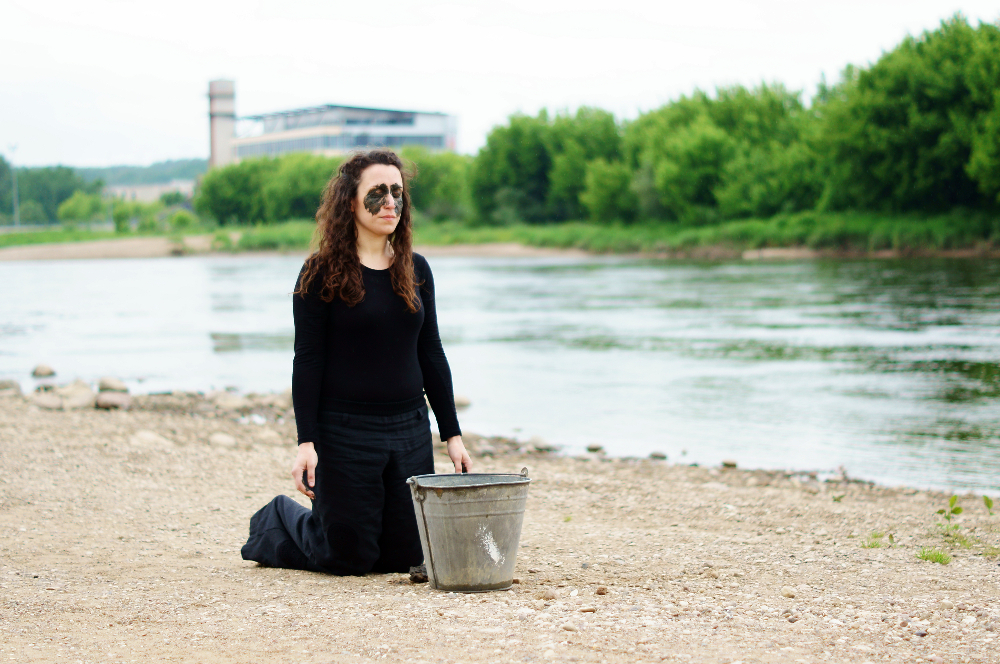
Christina Georgiou, Eternal Return #7
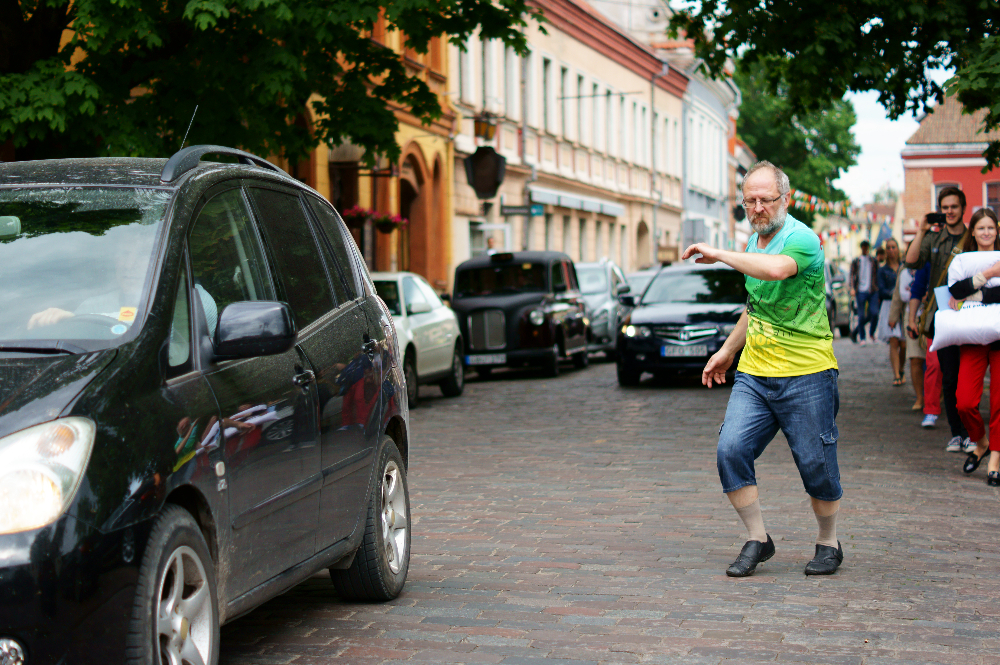
Redas Diržys, Dancing in the Street
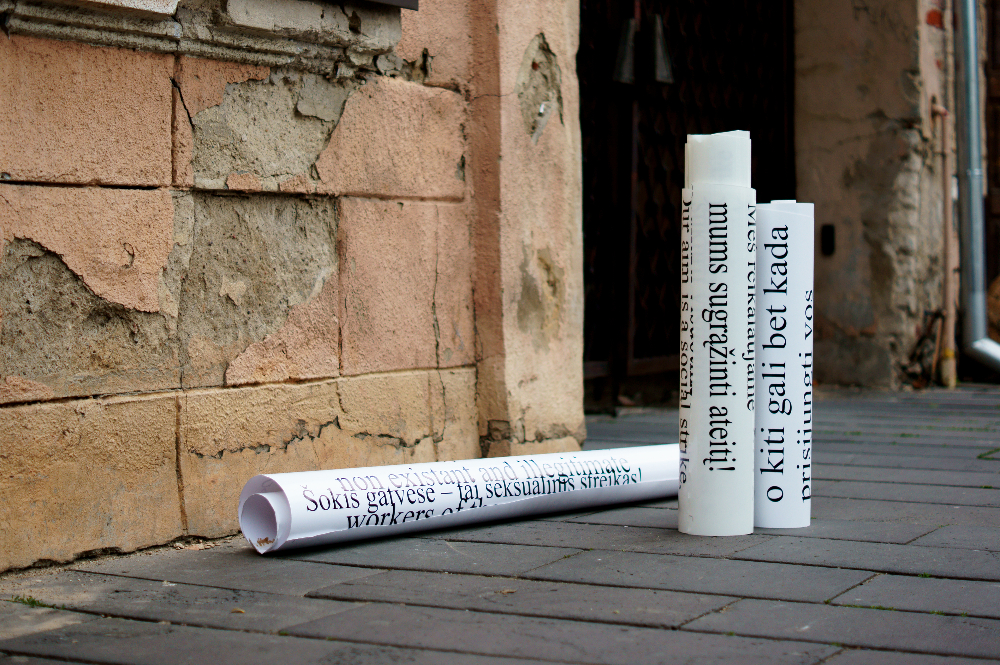
Redas Diržys, Dancing in the Street
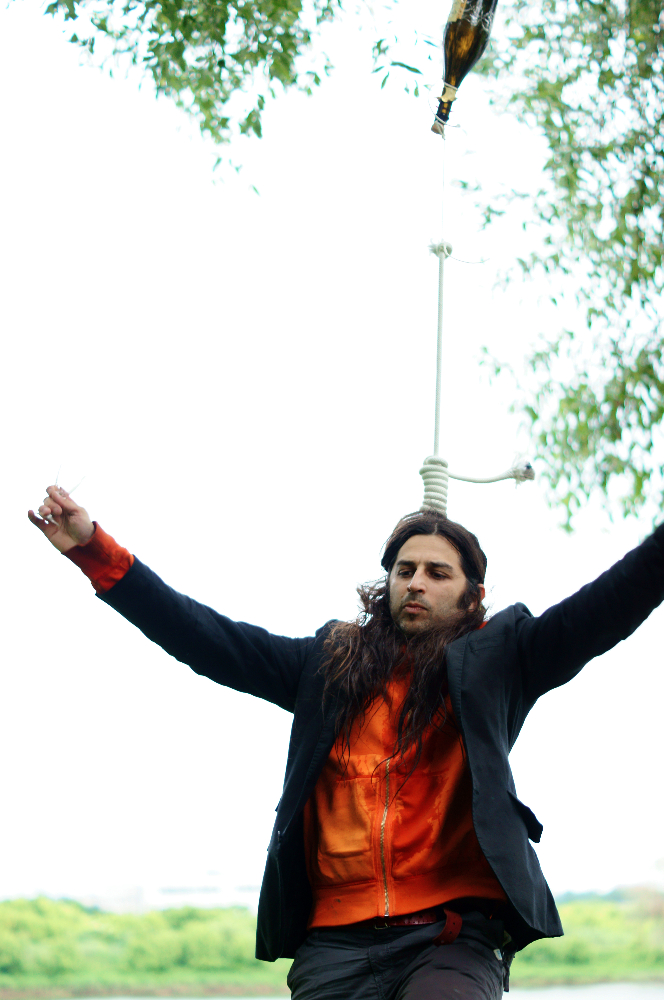
Tomasz Szrama, Suicide Attempt Doomed to Failure
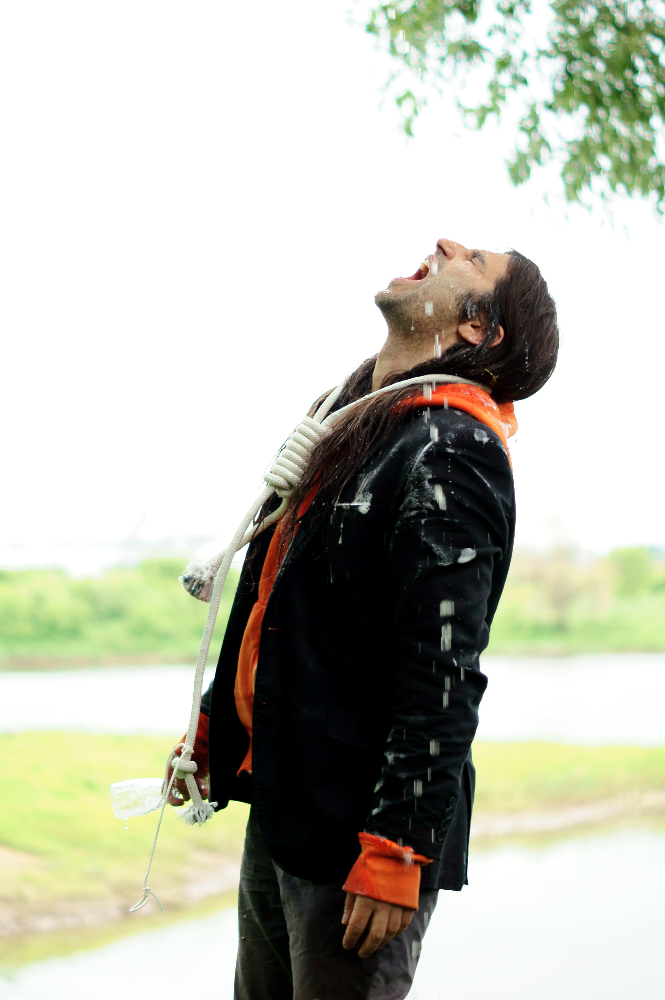
Tomasz Szrama, Suicide Attempt Doomed to Failure
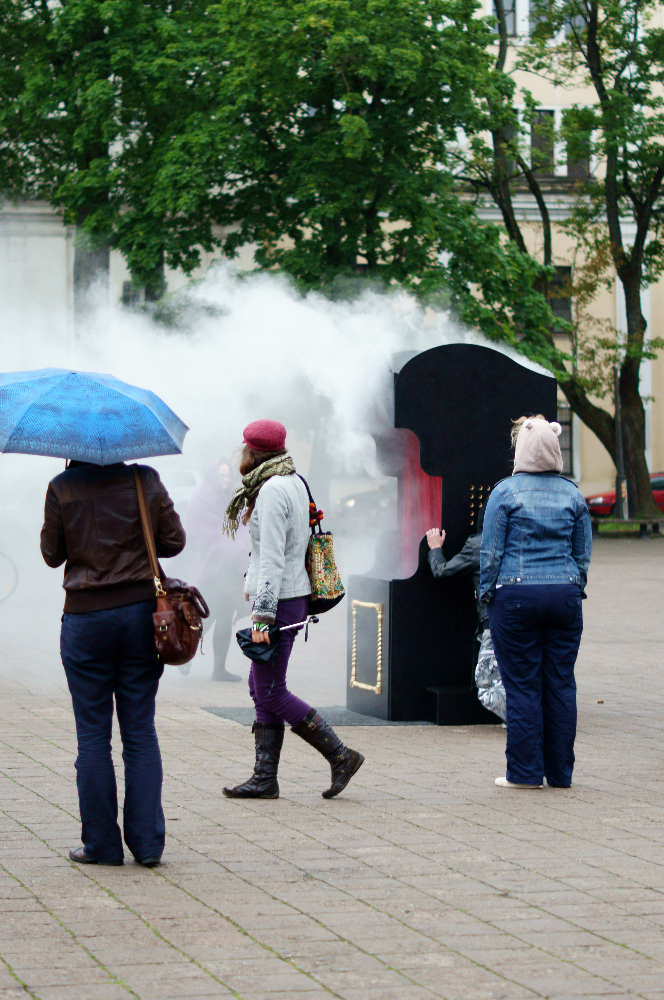
MeKuSa, Kristijonas Confessional
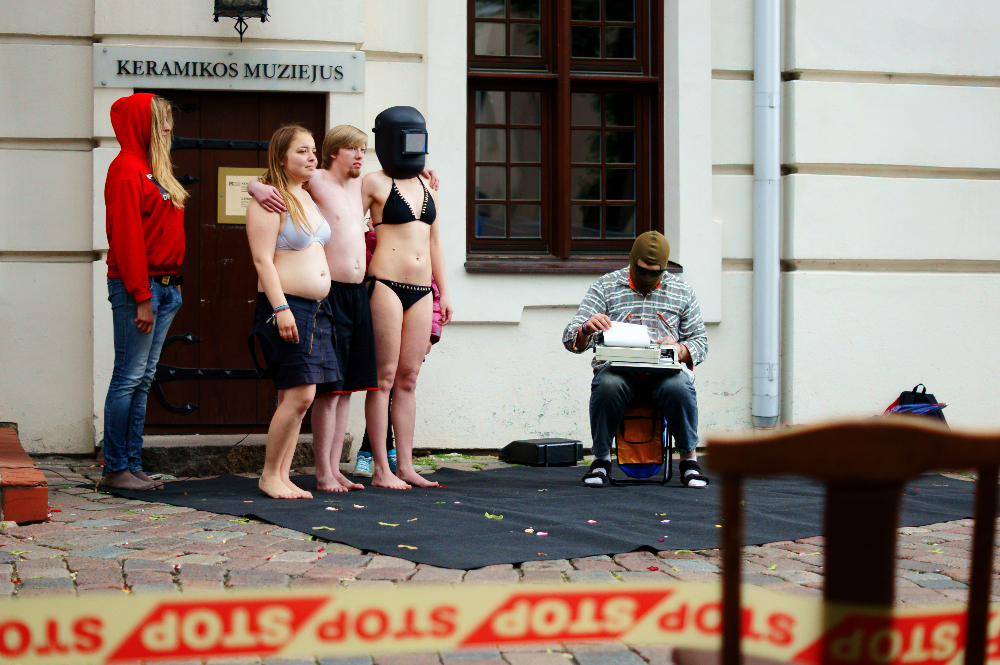
Ramūnas Jaras, Flags
Photographs by Karolina Černevičienė






























